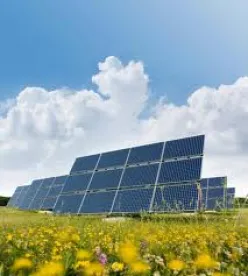As part of an ongoing Department of Defense (“DoD”) effort to increase its energy efficiency, late last month the U.S. Army committed to develop its largest renewable energy project to date — a 65MW wind and solar project at Fort Hood. This ambitious project will need to comply with the latest DoD rules regarding sourcing requirements for photovoltaic (“PV”) devices. We previously analyzed the proposed rule issued by DoD in May 2015 that placed stricter sourcing requirements on PV devices. Toward the end of last year, DoD issued a final rule implementing the requirements of the proposed rule with relatively minimal, but still notable, changes. The solicitation for the Fort Hood project was amended to add the updated DFARS clause implementing this final rule. The final rule tightens the sourcing restrictions for PV devices and may raise some compliance challenges for contractors.
Background on DoD Contractor PV Requirements
DoD-specific PV sourcing rules have been in place since 2011 when they were promulgated through an interim rule to implement requirements in the National Defense Authorization Act (“NDAA”) for Fiscal Year (“FY”) 2011. The interim rule required PV devices used on certain DoD contracts to comply with the Buy American Act (“BAA”). The covered contracts were those that resulted in DoD ownership of PV devices (other than DoD purchase of PV devices as end products) if the devices were (1) installed on DoD property or in a DoD-owned facility and (2) reserved for the exclusive use of DoD for the full economic life of the device. (Think power purchase agreements and energy savings performance contracts.) Notably, the contract had to meet both of these two criteria for the DoD-specific sourcing restrictions to apply.
Compliance with the BAA typically required use of domestic PV devices (i.e., PV devices manufactured in the United States). But the interim rule also had a number of express exceptions which, depending on the value of the contract, allowed a contractor to use PV devices from other sources, such as qualifying or designated countries. It also left open the possibility that a contractor could be given permission to use foreign PV devices where the cost of domestic PV devices was unreasonable.
Recent Revisions to the PV Requirements
The proposed and final rules were issued to implement the requirements in the FY 2015 NDAA. The final rule confirmed the stricter sourcing requirements contained in the proposed rule, many of which were summarized in our previous post. Chief among these is the expanded number of covered contracts to which the sourcing requirements apply. Under the final rule, covered contracts are those that provide for a PV device (other than as an end product) to be (1) installed in the U.S. on DoD property or in a DoD-owned facility or (2) reserved for the exclusive use of DoD in the U.S. for the full economic life of the device. Thus, contracts need only meet one of these criteria — as opposed to both under the 2011 interim rule — to be subject to the sourcing requirements. This may considerably expand the number of contracts and contractors that need to comply with this rule.
The final rule also confirms that compliance with the domestic PV device requirement will turn on the value and origin of components in the PV device. Whereas the proposed rule contemplated that a PV device provided on a covered contract had to be “manufactured in the United States substantially all from articles, materials, or supplies mined, produced, or manufactured in the United States,” the final rule simply states that the PV device must be a “domestic photovoltaic device.” The final rule defines a “domestic photovoltaic device” as a PV device that is manufactured in the U.S. and that the cost of its components mined, produced, or manufactured in the U.S. exceeds 50 percent of the cost of all components. This explicit definition will require contractors to pay attention not only to where the PV device is manufactured, but also to the cost and origins of the components of the PV device.
As detailed in our earlier post, the proposed, and now final, rule removed a number of the express exceptions and waivers that were in the 2011 interim rule. The comments accompanying the final rule did, however, reiterate that the rule is still subject to the Trade Agreements Act (“TAA”), which likely would apply to a majority of the covered contracts given the high value of these types of contracts. When the TAA applies, a contractor can utilize PV devices that were substantially transformed in a qualifying country. However, DoD rejected a request that the final rule explicitly state that for purposes of TAA compliance, substantial transformation of a PV device takes place in the country where the PV device’s cell is manufactured. The Department of Commerce has defined substantial transformation as such, but the DoD stated rather unhelpfully that such a determination was not in its purview.
What Does This Mean for Contractors?
In light of the final rule, contractors using PV devices on a DoD project should take a few practical steps to ensure compliance with these sourcing requirements. First and foremost, contractors should determine if the expanded reach of the rule includes a contract under which they are performing. For example, if a contractor is selling power exclusively to the government from PV devices located on private land, such a contract is now subject to these sourcing requirements. Under the interim rule, this would not be the case.
Second, contractors may need to pay close attention to the cost and origins of the components in their PV devices where the contract does not qualify for an exception or waiver to the requirement for a domestic PV device. Given the complexity of determining the origin of the components, affected contractors should coordinate with their suppliers.
Third, where necessary, contractors should pursue the waivers that the final rule allows on a case-by-case basis. In the comments to both the proposed and final rules, DoD acknowledged that the rule will require contractors to track the origin of PV device components but also stated that it “expects to grant waivers as appropriate.”
Finally, compliance with DoD’s PV sourcing requirements should be assessed as early as possible so that any cost impact can be priced into the project budget. Questions regarding permissible sources of supply should not be deferred until after contract award.





 />i
/>i

